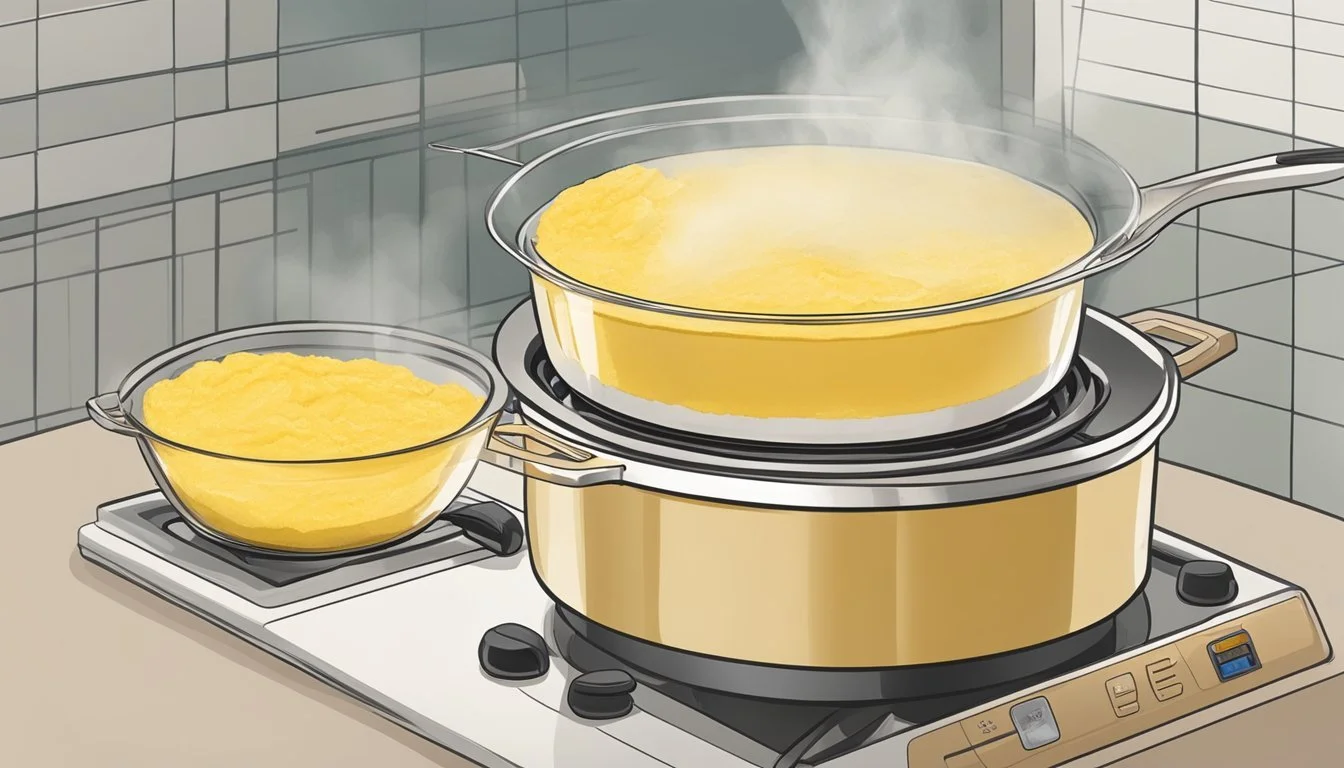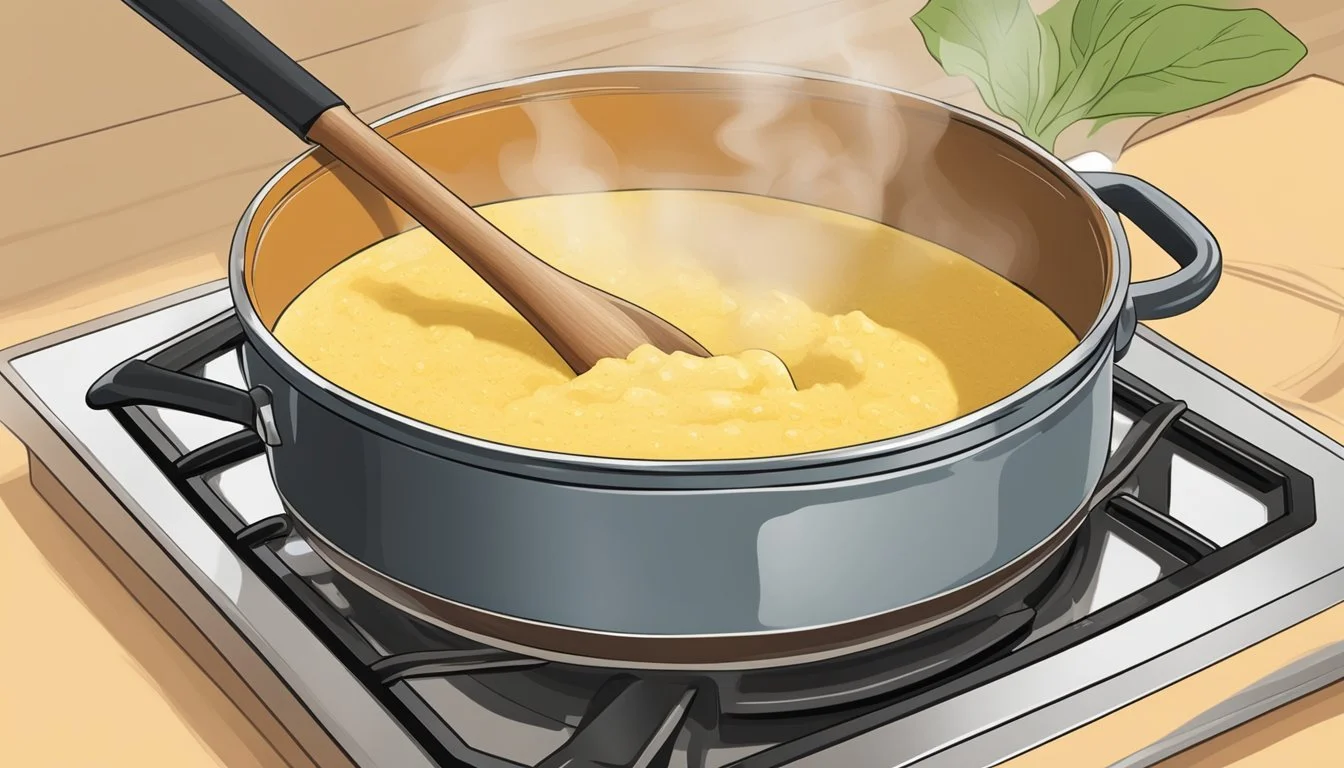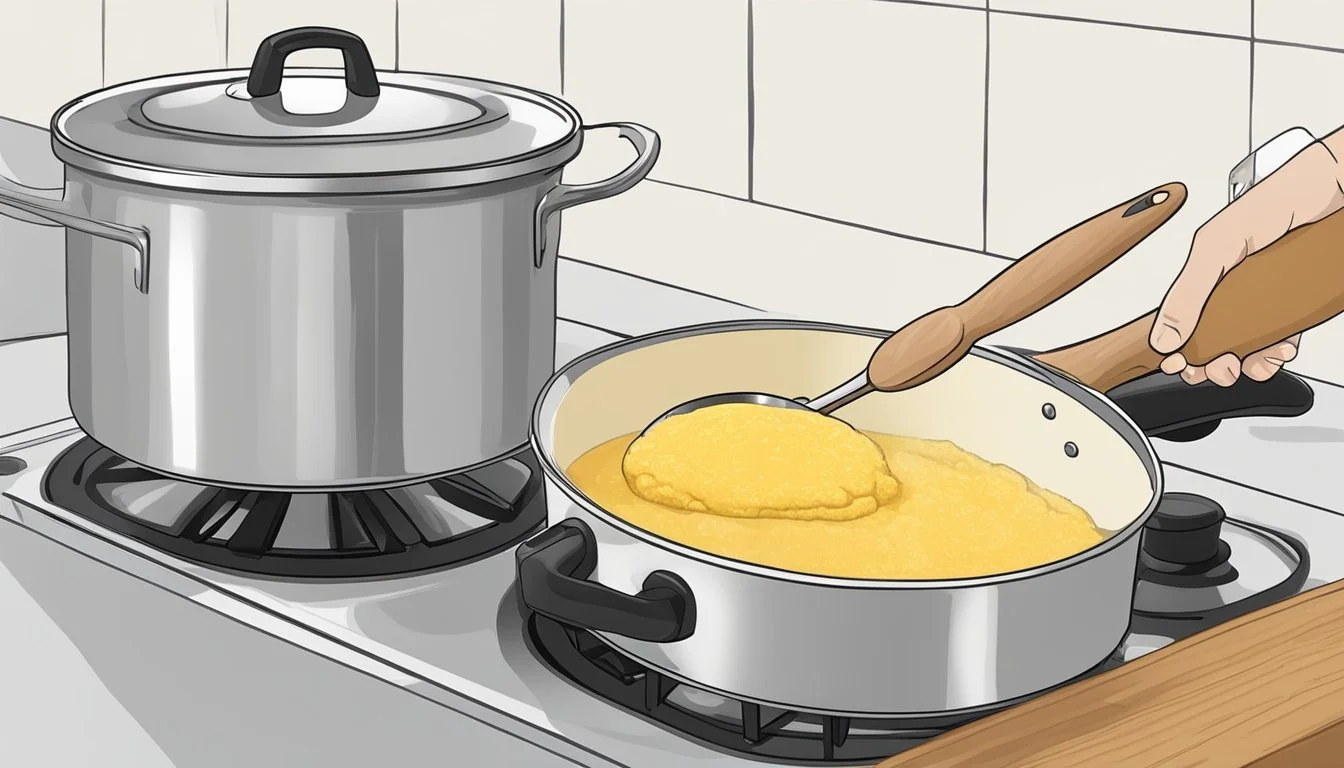Best Way to Reheat Creamy Polenta
Tips for a Smooth, Lump-Free Dish
Creamy polenta, an Italian staple, is a versatile side dish beloved for its smooth texture and ability to complement a variety of main courses. Made from cornmeal, it serves as comfort food to many, offering a pleasant base to robust sauces and hearty meats. When prepared fresh, polenta's creamy consistency is a culinary delight, but it can present a challenge to reheat while maintaining the smooth, lump-free texture that defines the dish.
Reheating polenta without compromising its quality necessitates a gentle approach. Whether one opts to use a microwave, stovetop, or oven, the key is to incorporate moisture and heat it slowly. This allows the polenta to regain its creamy texture as if it has just come off the stove. Adding liquid such as water, milk, or broth can help prevent it from drying out or becoming unappetizingly thick.
It's essential to stir polenta frequently during reheating, regardless of the selected method, to ensure even warming and to keep it smooth. By following these careful steps, what was once firm and solid can be revived to the soft, creamy consistency that so many enjoy, restoring the comforting and satisfying characteristics of traditional Italian polenta.
Understanding Polenta
Polenta is a traditional northern Italian dish made primarily from cornmeal; its versatility allows for both creamy and coarse textures. This section will clarify the basic composition of polenta, the textural differences between its creamy and coarse variants, and address some common misconceptions.
Polenta Basics
Polenta is made from ground yellow corn, typically from a specific type known as flint corn. This variety of corn produces a granular texture that is prized in the creation of polenta. Traditionally, polenta is associated with the Northern Italian regions of Lombardy and Veneto, where it is a staple of the local cuisine. It is a simple dish, both in preparation and ingredients, often enjoyed for its comforting consistency and as a versatile accompaniment to various toppings and sauces.
Key Points:
Basic ingredient: Yellow cornmeal
Origin: Northern Italian regions such as Lombardy and Veneto
Texture: Often granular, but the fineness can vary
Creamy vs. Coarse Polenta
The consistency of polenta can range from creamy to coarse, depending on the grind of the cornmeal and the cooking technique.
Creamy polenta is made with a finer grind and requires frequent stirring to maintain a smooth, velvety consistency. It's often enriched with butter, cheese, or cream, and served immediately.
Coarse polenta, on the other hand, uses a coarser grind that results in a robust texture and is often allowed to set before being sliced and possibly fried or grilled.
Consistency Comparisons:
Creamy: Fine grind, stirred constantly, enriched with fats
Coarse: Coarse grind, set after cooking, potentially fried or grilled
Common Misconceptions
Polenta vs. Grits: A common misconception is that polenta and grits are interchangeable. While both are derived from corn, grits are typically made from a type of corn called hominy and often from white corn, giving them a different flavor and texture profile.
Vegetarian Dish: Polenta itself is a vegetarian dish, as it is primarily cornmeal and water. However, non-vegetarian ingredients like chicken broth or cheese are often added for flavor.
Cooking Difficulty: Some might believe that making polenta is labor-intensive. While it does require attention, especially when aiming for a creamy texture, the process is straightforward and rewarding.
Correction of Misconceptions:
Grits are not the same as polenta; they have different corn bases.
Polenta is vegetarian but can be adapted with various add-ins.
The cooking process is simple, though it requires some care.
Ingredients and Ratios
Achieving the perfect consistency for reheated creamy polenta relies on understanding the ideal ratios and choosing high-quality ingredients. This section delves into the specifics for both aspects to ensure that reheated polenta retains a smooth, lump-free texture that is as close as possible to its freshly cooked counterpart.
Ideal Ratios for Polenta
For original preparation, the ratio typically involves:
Water (or stock): 4 parts
Cornmeal: 1 part
Salt: To taste
During reheating, maintain creaminess by adding liquid:
Water/Stock/Milk: Add small increments (1 tablespoon at a time)
Butter/Olive Oil: 1 tablespoon for every cup of polenta
Cheese: According to preference, often a generous sprinkle
Adjust the ratios of liquid to polenta based on the desired consistency, with more liquid making it looser and less for a firmer texture.
Choosing Your Ingredients
The quality of ingredients used in reheating affects the outcome significantly.
Liquids: Use water, milk, or a combination of both. Vegetable or chicken stock can intensify the flavor.
Fats: High-quality butter or olive oil can add richness.
Cheese: Freshly grated Parmesan cheese provides a savory finish.
Seasonings: Salt and pepper should be added to taste, considering that some cheeses and stocks contain salt.
Quality ingredients ensure that the reheated polenta is flavorful, creamy, and retains the right consistency.
Preparation Techniques
When reheating creamy polenta, the method chosen is crucial to maintain its smooth and lump-free texture. Proper preparation techniques can ensure the polenta retains its creamy consistency and rich flavor.
Cooking Polenta on Stove
For stovetop reheating, one must transfer the polenta to a pot and place it over medium-low heat. It's essential to stir the polenta frequently with a wooden spoon to prevent sticking and clumping. If the polenta seems too thick, a splash of water or milk can be added to achieve the desired creaminess. The cooking time on the stove typically ranges from 5 to 10 minutes, but one should watch for the polenta to reach the appropriate warm, creamy consistency.
Prep Time: 2 minutes
Cook Time: 5-10 minutes
Total Time: 7-12 minutes
Polenta in Slow Cooker
Using a slow cooker requires one to add the polenta with some liquid, such as water or broth, to avoid drying out. The polenta should be stirred occasionally—every 20 minutes or so—to ensure even heating and to maintain a creamy texture. This method is gentle, and the slow cooker should be set on a low setting to simmer the polenta, this process may take around an hour or more depending on the quantity.
Prep Time: 5 minutes
Cook Time: 1 hour
Total Time: 1 hour 5 minutes
Baking Polenta
For the oven method, the polenta requires spreading evenly into a baking dish. It can be baked at 350°F (175°C) until it is thoroughly warmed, which typically takes about 25-30 minutes. Stirring midway through the baking process can help prevent a skin from forming on the top and promote an even consistency throughout.
Prep Time: 5 minutes
Cook Time: 25-30 minutes
Total Time: 30-35 minutes
Each method serves to reheat polenta without losing its creamy quality. One should consider the total time and the equipment available when selecting the preparation technique.
Reheating Polenta
Reheating polenta correctly is essential to maintain its creamy texture and avoid lumps. The methods outlined below utilize heat and moisture control to ensure a smooth consistency.
Stovetop Reheating Method
For the stovetop method, one begins by adding a small amount of olive oil or butter to a saucepan over medium-low heat. Once the fat has melted, they add the creamy polenta to the pan. It's important to stir the polenta frequently with a whisk or spoon, and to add liquid—such as cream, milk, or water—to prevent it from drying out and to help achieve a creamy consistency with no lumps.
Microwave Reheating Method
When reheating polenta in a microwave, the polenta should be placed in a microwave-safe bowl. Initially, it should be heated for a minute before being stirred thoroughly. If the texture seems too thick, they may add a few drops of water or milk. The stirring and heating process should be repeated in short intervals until the polenta is evenly warm and creamy.
Oven Reheating Method
Reheating polenta in the oven starts by preheating the oven to 350°F (175°C). The polenta should be spread in an even layer across a baking dish and covered with a layer of plastic wrap to retain moisture. The polenta requires occasional stirring and may need additional liquid to keep it from drying out. They should heat it until it's warmed through to a creamy consistency.
Avoiding and Fixing Lumps
To avoid lumps, polenta should be reheated slowly and stirred continuously. If lumps do form, they can often be smoothed out by whisking vigorously. Additional liquid can be incorporated in small amounts to aid in achieving the desired smooth texture. If the polenta has cooled down to a solid state, slicing it before reheating and then mashing it back to a creamy consistency can also be effective.
Enhancing Flavor and Texture
To elevate reheated polenta, they must consider the addition of flavorful fats and complementary garnishes to enrich both its flavor and texture.
Stirring in Extras
Reheating polenta is an opportunity to introduce extra richness and smoothness. They can stir in butter for a silky mouthfeel or a drizzle of olive oil for a touch of fruitiness. Incorporating cream can help return creaminess to the polenta and prevent dryness. For those who enjoy cheese, stirring in Parmesan cheese as the polenta reheats not only infuses it with a nutty, savory element but also contributes to a delightfully creamy texture.
Pairing with Sauces and Garnishes
Enhancing polenta doesn't stop at the dish itself—sauces and garnishes play a crucial role. A simple tomato sauce can add acidity and depth, while a touch of black pepper brings a necessary kick. In terms of garnishes, options include a sprinkle of finely chopped onion or garlic that has been sautéed until golden, enriching the polenta with aromatic sweetness. A thoughtful selection of garnishes, like fresh herbs or sautéed mushrooms, lends a final touch of complexity and visual appeal.
Serving Suggestions
Creamy polenta, with its versatile nature, can enhance a variety of main courses and side dishes. It offers a perfect canvas for different flavors, providing an exceptional experience whether one opts for a hearty meat accompaniment or a lighter vegetarian meal.
Pairing with Proteins
Creamy polenta pairs exceptionally well with robust meats such as grilled steak, roasted chicken, (What wine goes well with roasted chicken?) or even braised lamb. It also complements delicate proteins; for example, sautéed shrimp served on a bed of creamy polenta absorbs the rich sauce, offering a balanced and satisfying dish.
Meat Options:
Grilled steak
Roasted chicken
Braised lamb
Seafood Options:
Sautéed shrimp
Vegetarian Meal Ideas
As for a vegetarian meal, polenta shines when served alongside sautéed mushrooms, which bring an earthy element to the dish. One can also consider a medley of seasonal roasted vegetables or a rich ratatouille (What wine goes well with ratatouille?) to create a comforting and nutritious Italian-inspired meal.
Vegetable Pairings:
Sautéed mushrooms
Roasted seasonal vegetables
Ratatouille
Polenta as a Base for other Dishes
Lastly, creamy polenta can serve as an excellent foundation for a variety of dishes. It's often used beneath hearty Italian ragùs or as a base for a vegetarian stew. When setting the stage for toppings, polenta transforms into an Italian dish that carries flavors and adds a texture that is both substantial and smooth.
Dish Foundations:
Italian ragùs
Vegetarian stews
Preserving and Storing
The key to enjoying polenta at another time is proper storage. Doing so will preserve its creamy texture and prevent it from becoming dry or lumpy.
Storing Fresh Polenta
To keep fresh polenta in its best condition, one should cool it down before storing. Once cooled, transfer the polenta to a suitable container and cover it with plastic wrap in direct contact with the surface. This method decreases air exposure and helps maintain moisture. It is best stored in the refrigerator if intended for consumption within a few days.
Freezing and Thawing
Freezing polenta is an effective way to extend its shelf life. To freeze, divide the polenta into portion-sized chunks, place them on a tray, and freeze until solid. Once solid, wrap the chunks individually in plastic wrap to protect against freezer burn and then place them in a freezer bag or an airtight container. To thaw, transfer the polenta to the refrigerator overnight. It's crucial to ensure it thaws slowly to preserve its texture.
Frequently Asked Questions
Can I reheat instant polenta and maintain its creamy texture?
Yes, one can reheat instant polenta while preserving its creaminess. For best results, stir it continuously and consider adding a small amount of liquid such as water, milk, or broth to maintain the smoothness.
What is the difference between coarse ground cornmeal and coarse cornmeal in polenta?
The terms "coarse ground cornmeal" and "coarse cornmeal" are often used interchangeably. They both refer to cornmeal with a larger, grittier texture, ideal for creating the traditional texture of polenta.
How do I prevent polenta from becoming gritty when reheating?
To prevent polenta from turning gritty, reheat it slowly on low heat, stirring regularly. Rushing the reheating process can cause the starch to seize up, creating a gritty texture.
Are there polenta recipes that are better for reheating?
Recipes that incorporate plenty of liquid, such as broth or cream, tend to reheat better since they help maintain the desired creamy consistency.
What's the best method to reheat polenta without it getting lumpy?
The stovetop method is typically best for reheating polenta without it becoming lumpy. Stirring constantly over low heat ensures even warming and smoothness.
Note: When reheating polenta, patience is key. Allowing starch in the cornmeal to slowly rehydrate helps in avoiding lumpiness and achieving a uniformly heated dish.
Creative Uses for Leftover Polenta
When faced with leftover polenta, there are several inventive ways to transform it. These methods ensure the creamy and porridge-like consistency of fresh polenta isn’t compromised, but rather repurposed into something equally delightful.
Baked Polenta Fries
One can slice the chilled polenta into sticks and season them to preference. A quick bake in the oven on a sheet pan, preferably lined with parchment paper for non-stick purposes, results in crispy Baked Polenta Fries. Baking at 425°F for 20-25 minutes, flipping halfway through, will give them a golden crunch.
Preheat oven to 425°F (220°C)
Cut polenta into sticks and season
Place on a baking sheet lined with parchment paper
Bake for 20-25 minutes, flipping once
Polenta in Casseroles
Chilled polenta leftovers can add structure to casseroles. They can be cubed and layered in a baking dish with vegetables, meats, or cheeses. Adding a splash of vegetable broth can help keep the polenta moist during the baking process at 375°F until heated through and the top is bubbling and browned.
Cube the polenta
Layer in a casserole with other ingredients
Pour a dash of vegetable broth over
Bake at 375°F until bubbling
Making Polenta Cakes
Leftover polenta can be formed into cakes or slices and fried to create a satisfying texture and warmth. One may heat a bit of oil in a cast iron skillet and add the polenta cakes, frying each side until they're golden and crispy. Serving with a sauce or as a side like cornbread can add versatility to any meal.
Shape polenta into cakes
Heat oil in a cast iron skillet
Fry until each side is golden
Serve with your preferred sauce







